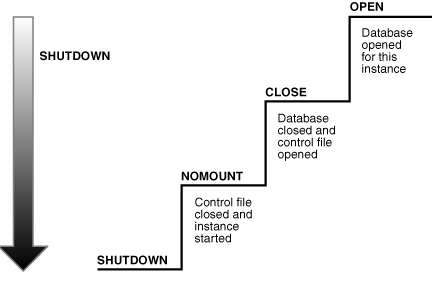

Other users, including those with the DBA role, are not allowed to issue the ALTER SYSTEM QUIESCE DATABASE statement or proceed after the database is quiesced. In this discussion of quiesce database, a DBA is defined as user SYS or SYSTEM. You can either put the remote procedure call in a stored procedure, or you can invoke the remote procedure in the database before it becomes read only. This limitation applies to remote procedure calls in anonymous PL/SQL blocks and in SQL statements. You cannot invoke a remote procedure (even a read-only remote procedure) from a read-only database if the remote procedure has never been called on the database. To minimize PL/SQL invalidation because of remote procedure calls, use REMOTE_DEPENDENCIES_MODE=SIGNATURE in any session that does remote procedure calls on a read-only database. You cannot compile or recompile PL/SQL stored procedures on a read-only database. This is true even if you execute a generic SELECT statement on the first database link and the transaction is currently read-only.

When executing on a read-only database, you must commit or roll back any in-progress transaction that involves one database link before you use another database link. If your application calls any of these functions and procedures, or if it performs any of the preceding operations, your application writes database objects and hence is not read-only. Many of the functions and procedures in Oracle-supplied PL/SQL packages, such as DBMS_SCHEDULER, write database objects. An application writes database objects when it locks rows, when it runs EXPLAIN PLAN, or when it executes DDL. An application writes database objects when it manipulates a database sequence. For example, an application writes database objects when it inserts, deletes, updates, or merges rows in a database table, including a global temporary table. See " srvctl add service" and " srvctl modify service" for the syntax for setting the management policy of and Data Guard roles for a service.Īn application must not write database objects while executing against a read-only database.
#Oracle database startup time manual#
A service automatically starts upon manual database startup only if the management policy of the service is AUTOMATIC and if one of its assigned roles matches the current role of the database. In an Oracle Data Guard (Data Guard) environment in which databases are managed by Oracle Restart, you can additionally control automatic startup of services by assigning Data Guard roles to the services in their Oracle Restart configurations.

A MANUAL setting does not prevent Oracle Restart from monitoring the service when it is running and restarting it if a failure occurs. If you set the management policy to MANUAL, the service does not automatically start, and you must manually start it with SRVCTL. If you set the management policy for a service to AUTOMATIC (the default), the service starts automatically when you start the database with SRVCTL. When your database is managed by Oracle Restart, you can configure startup options for each individual database service (service). If you specify both the spfile_name and the FROM PFILE clause in a CREATE SPFILE statement, and the database is defined as a resource in Oracle Clusterware, then this statement automatically updates the SPFILE name and location in the database resource. If DBCA created the SPFILE in an Oracle Automatic Storage Management disk group, then the database searches for the SPFILE in the disk group. The first three files are SPFILEs and the fourth is a text initialization parameter file. You can check the current setting with the srvctl config database command. The location specified by the -spfile option in the SRVCTL commands srvctl add database or srvctl modify database In the platform-specific default location, Oracle Database locates your initialization parameter file by examining file names in the following order: Table 2-3 lists PFILE and SPFILE default names and locations. If it finds no SPFILE, then it searches for a text initialization parameter file. When you start the database instance, it attempts to read the initialization parameters from an SPFILE in a platform-specific default location.


 0 kommentar(er)
0 kommentar(er)
